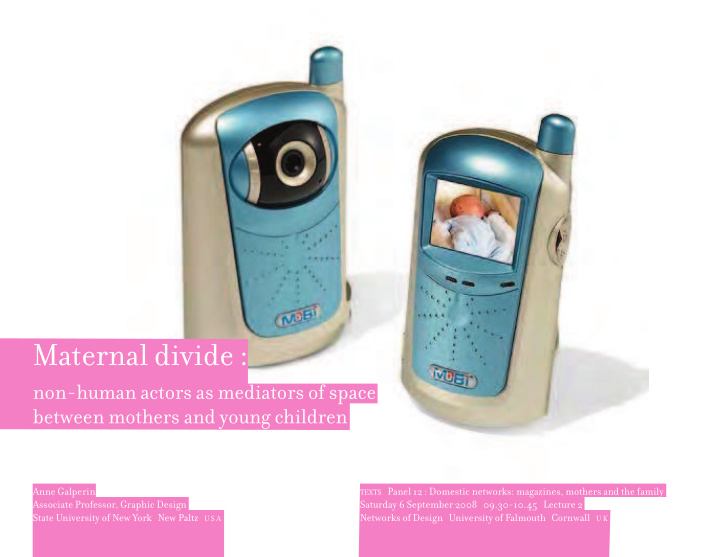



Maternal divide : non-human actors as mediators of space between mothers and young children Anne Galperin TEXTS Panel 12 : Domestic networks: magazines, mothers and the family Associate Professor, Graphic Design Saturday 6 September 2008 09.30-10.45 Lecture 2 State University of New York New Paltz U S A Networks of Design University of Falmouth Cornwall U K
1. Context : How do I succeed at being a good mother ?
Enlist help.
2. Network goals : A well-nourished, well-rested, healthy, clean, happy baby cared for in a safe, loving, physically and intellectually stimulating environment.
nursing pillows breast pumps milk storage systems breast milk defrosters sippy cups squeezable spoons self-feeders seating props walkers stairway gates cabinet locks safety gates mobile fencing furniture bumpers kneepads baby monitors outlet plugs crib rockers cry analyzers sanitizers leashes 3. Preliminary research questions : • What outcomes are non-human actors enlisted to promote or prevent? • What experiences, responses, and results follow?
4. Methodologies : [a] Examining inscriptions and activities of non-human actors [b] Conversing with mothers
4. [a] Inscriptions / activities : nourishment intimacy risk reduction portability convenience cleanliness independence
4. [a] Inscriptions / activities : mobility ( ) intimacy risk reduction comfort independence
4. [a] Inscriptions / activities : prevention risk reduction (barrier and signal) independence
4. [a] Inscriptions > conclusions : The use of non-human actors may • reduce parental anxieties • reduce actual risks • introduce alternate /safer skills • reduce the ability to assess risk • reduce the ability to deal with risk
4. [b] Conversations : the baby monitor “Using a monitor is just something I do ... like using diapers.”
4. [b] Conversations > context: the baby monitor Baby monitors are ubiquitous nursery items. They enable mothers to be in audio contact with their children when out of visual range, generally within domestic space. Monitors are most often used at nap time and during nighttime sleep. The transmitter is generally kept stationary at the child’s end, while the receiver at the adult end may frequently be in mobile use.
4. [b] Conversations > findings : the baby monitor When baby calls at night, moms, for a variety of reasons, are generally more frequent responders.
4. [b] Conversations > findings : the baby monitor Moms respond in a variety of ways, treating the audio call as • a signal of trouble (time to run into the child’s room) • initiating a period of diagnosis (wait and evaluate) • initiating 2-way communication (talk to, with child)
4. [b] Conversations > findings : the baby monitor The baby monitor is an actor that provides “peace of mind.” But it “makes you crazy if you overuse it,” and also “makes everything sound creepy.” Some mothers complained they “heard every little sleep sound,” and that the monitor “pulled me out of my head.”
4.[b] Conversations > conclusions : Baby monitors simultaneously empower and disempower mothers, leading to • a wider range of responses to the child’s call • a (false?) sense of security, • exacerbated maternal hypervigilance and anxiety
4.[b] Conversations > conclusions : Alternatives to monitor use: • increase physical proximity between mother and child • eliminate sound barriers at home
5. Preliminary conclusions : Non-human actors are enlisted by mothers to help in childcare activities. The results range widely in terms of how and how well non-human actors meet network goals. Mothers freely make changes to the network as they negotiate the balance of their needs and what’s best for their child.
Maternal divide : non-human actors as mediators of space between mothers and young children Anne Galperin TEXTS Panel 12 : Domestic networks: magazines, mothers and the family Associate Professor, Graphic Design Saturday 6 September 2008 09.30-10.45 Lecture 2 State University of New York New Paltz U S A Networks of Design University of Falmouth Cornwall U K
Recommend
More recommend